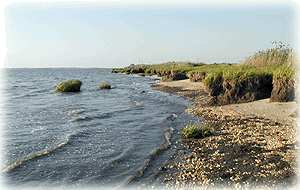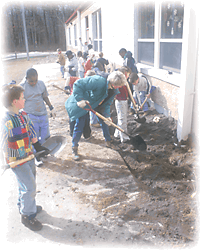 |
|
|||
Objectives The objectives of developing a school yard habitat and outdoor classroom are as varied as the potential projects to be incorporated. The main purpose here is to provide enough ideas and potential resource information to inspire teachers to embark on projects that will improve the overall ecological health of their school yard, the environment, and their watershed. Resource materials on this subject abound, and teacher training, including considerable classroom curricula and resources, is available from: Pequest Trout Hatchery and Resource Education Center A sample lesson plan follows, entitled “Linking the School and Community through Gardening — Hands-on with Flowers and Seeds.” Materials A significant number of materials are needed to implement a habitat improvement project on school grounds. Most of these materials and equipment are the same ones needed for yard care around our homes. Making Connections The main goal of creating school yard habitats is indeed complementary to the main goal of this teacher’s guide. That is, the main purpose is to instill in students an appreciation and sense of stewardship for their place — their region and watershed — Down Jersey and the Delaware Bay — and their piece of it — being their school yard and their very own backyards.
Each school yard is unique and requires specific consideration when undertaking an enhancement project. An excerpt from the Homes for Wildlife guidebook, Marilyn C. Wyza, New Hampshire Fish and Game Department: The Habitat Enhancement Advantage “Whether your school yard is one paved acre or a 100-acre forested site, this outdoor resource can provide you and your students with a unique learning experience. You can benefit from both the process of developing a habitat enhancement project and the resulting outdoor classroom. At the same time, you can influence positive change for wildlife. Safety issues, logistical concerns, or feelings of anxiety on the part of teachers often lead to an under utilized schoolyard. You can use this space successfully with the right ideas and guidance. Though not a quick and simple task, enhancing wildlife habitats in your schoolyard is an exciting and manageable project, providing challenges and rewards. Students and teachers can explore, discover and learn with every season.” Procedure Warm Up
For the first time in human history, many children are growing up in biologically impoverished environments. In our cities and suburbs, few of the original landforms, streams, natural ecosystems or wild plants still exist. Schools can help fill this void by creating diverse learning environments around school buildings. Here are a few suggestions: A Wet Area such as a stream, pond or marshy spot will attract larger animals and provide habitat for turtles, fish, frogs and salamanders. Natural wetlands are among the richest areas biologically, but are often ignored and too often destroyed. A Hardwood Forest should include native hardwood trees: oaks, maples, hickories, walnuts, ashes, cottonwood and others. Dead and decaying logs, stumps and leaves should be allowed to remain in the woodland. Other plants, including native shrubs and wildflowers common to wooded areas, will add beauty and diversity. Pines or Other Evergreens provide a completely different habitat. Owls, small songbirds, northern red squirrels and other interesting animals utilize evergreens. The cedar swamp is of particular significance to the Down Jersey region and the Pinelands National Reserve. Here, many endangered species make their home, like the Pine Barrens Treefrog, the Timber Rattlesnake, the Bald Eagle; and the endangered plants, the Bog Asphodel and Swamp Pink find refuge. These also provide attractive green in winter and are aesthetically pleasing. Please remember to plant evergreens in clusters rather than rows to provide maximum interior cover for wildlife. A Tall or Short Grass Prairie consists of native grasses and wildflowers and is a place of great beauty. The prairie landscape is a significant part of our natural heritage. Ethics, land use and conservation of resources can be taught if this resource is available to students. A Brush Pile or Fence Row can provide the food, cover and space necessary to attract birds, mammals and other animals. Fence rows also act as wind breaks and travelways for wild creatures and add color and texture to the landscape. An Unmowed Meadow or Islands of Vegetation growing in a lawn will harbor an abundance of meadow wildflowers, tall grasses, small mammals and birds. A Boulder Field can include large glacial erratics, pieces of sandstone or flat limestone rocks bearing fossils. This adds interest to the site and aids in the study of geology. Smaller rocks will provide habitat for a variety of small creatures: earthworms, sowbugs, salamanders, centipedes, millipedes and others. A Hill is useful for giving a different perspective to the school ground, learning mapping skills and illustrating erosion and other physical laws. Vegetable Garden Plots offer an opportunity to watch food grow and be harvested. Organic methods and biological control of insects and weeds can be demonstrated. A Compost Pile is an essential in today’s world as it offers the opportunity to observe natural recycling. Kitchen, lawn and garden scraps can be placed on the compost pile instead of being sent off to the landfill. An Outdoor Seating Area can be incorporated anywhere on school property. Benches, large logs or log stools that are comfortable and provide off-the-ground seating should accommodate at least 30 students. Feeding Stations and Nest Boxes for birds and mammals can be placed in a variety of areas. These along with plant cover placed close to school windows offer the best opportunities to observe wildlife. When making changes in your school site, keep the following points in mind:
Wrap Up
Assessment Excerpt from Transforming School Grounds by Ann Coffey, Green Teacher, Issue 47, page 10. School grounds projects designed to bning nature back into our daily lives are crucial for the long term conservation, protection and restoration of wild places. Most young people never have the opportunity to experience wilderness: many living in urban settings have very limited opportunities to explore natural environments. As visits to outdoor education centers become limited by financial constraints, the danger exists that learning about the natural world will increasingly depend upon printed and electronic materials. Teaching in this way is largely an academic abstraction; it cannot foster the kind of lifelong ecological consciousness derived only from learning through the senses in natural settings throughout childhood. Nature, it has often been repeated, is our best teacher. If your school grounds are nothing but barren rectangles of hard surfaces and pounded grass, perhaps it is time to take a closer look at the options for changing your children’s living and learning environments and for de-paving the way to a better and more hopeful future. There can be no better place than our schools for beginning humanity’s greatest task — that of reconnecting ourselves to the natural world. Extensions Each new project brings more extensions and possibilities for using and enhancing the outdoor classroom and wildlife habitat areas created. Often, one of the projects initiated by schools — especially elementary schools — is creating a butterfly garden. Following is an example of a wonderful extension related to this specific type of project. Due to the fact that monarch butterflies pass through New Jersey in huge numbers during their migration, this seemed appropriate to include: Monitoring Monarch Mysteries School classes who join Monarch Watch receive tagging kits and monitoring instructions to use in the early fall. Some seek young butterflies in ditches and old fields where they can be found on milkweed. Others raise them in their classrooms from caterpillars collected from the underside of milkweed plants. Many are involved in gluing tiny tags to the monarch’s wings, allowing other monitors who find them to determine more precisely the migrating habits and the routes that the butterflies are taking on their southern journey. Observations are recorded and entered into a continental database used by scientists to unravel the mystery of the monarch’s migration.
Contact: Monarch Watch has three curriculum guides: K–2, 3–6, and Middle School. Fax: 785 684-4441 Please download the PDF for the complete Lesson Plan. Green Teacher is an excellent resource for any type of environmental education undertaking. Included in this packet is a flier on the back issues available, as well as subscription information. Pequest Trout Hatchery and Resource Education Center* Mimi Dunne, WILD School Sites Coordinator, * Teacher training, resource materials, network of others involved statewide, a recognition program, etc. Also, the contact for information about the New Jersey Coalition for School Yard Habitats. NJAS/Center for Research and Education New Jersey Audubon Society also has an excellent backyard habitats program. Contact them for more information and how to get involved. The Green Brook Road Ask for the complete listing of environmental education resources or specifically, their flier on resources for School Ground Naturalization. The Learning through Landscapes (LTL) collection is a series of books that examines using the school grounds in each of the following subject areas: Geography, Mathematics, English, and Science. They have many other resources — too numerous to list here. |
|||

 mproving the habitat on school grounds, the entire ecological health of the Down Jersey region. The process of awareness to action that is inherent to environmental education is realized to its fullest extent when such projects are undertaken. The notion of “Celebrating Our Sense of Place” is truly initiated when students are involved with projects that celebrate their own school grounds. The stewardship of the environment is indeed instilled and nurtured.
mproving the habitat on school grounds, the entire ecological health of the Down Jersey region. The process of awareness to action that is inherent to environmental education is realized to its fullest extent when such projects are undertaken. The notion of “Celebrating Our Sense of Place” is truly initiated when students are involved with projects that celebrate their own school grounds. The stewardship of the environment is indeed instilled and nurtured. Background
Background  The Activity
The Activity  Action
Action The ideal time to join Monarch Watch is May-June. The following contact can direct you to the nearest Monarch Watch coordinator. Expect to pay $12 per class to join.
The ideal time to join Monarch Watch is May-June. The following contact can direct you to the nearest Monarch Watch coordinator. Expect to pay $12 per class to join.